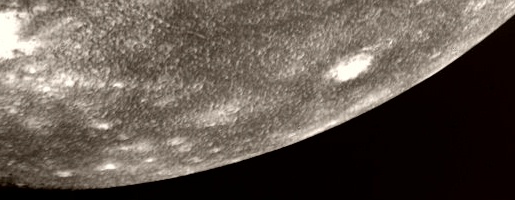 |
|
|
Voyager
1 image of Callisto from 325,000 kilometres.
|
|
| THE INTERIOR OF CALLISTO | |
| Even after the Voyager mission our knowledge of the interior of Callisto remained vague. The size and density of the moon were not known with any accuracy, limiting our understanding of Callisto's structure. | |
| Callisto is about the same size as Mercury, but with a density of just 1600 kg m-3, Callisto has the lowest of any moon. Such a low density led to early belief that Callisto comprised a great deal of water ice.Ideas of the internal structure of Callisto varied greatly. Some scientists thought that Callisto would be fully differentiated and its constituent materials separated into distinct layers. Others argued that Callisto would have the same rock and ice mixture throughout. In such a scenario the only variation with depth would be the type (or "phase") of ice that is stable under different pressure and temperature conditions. Ice located deep within Callisto's interior ice would have a more compact structure. | |
| The Galileo mission has done much to improve our knowledge of Callisto. It has borne out early conjecture of a layered interior and yielded fresh insights into the make-up of Callisto. As the Galileo probe flies by Callisto, the moon's gravity tugs at the probe and slightly changes the probe's speed. The strength of the pull depends on the structure of the moon's interior, and by studying the probe's change of speed scientists can determine the distribution of rock and metal inside the moon. | |
| The currently favoured model of Callisto's interior describes a thick crust of ice (with a little rock) between 200 and 300 kilometres thick. Below this is thought to be a liquid ocean about 10 kilometres deep. Evidence for an ocean below the crust comes from the variation observed in Callisto's magnetic field. It flows in different directions at different times according to changes in Jupiter's magnetic field. Beneath the ocean there is a thick mantle of ice and rock. There is some mixing in this layer but with increasing depth the ratio of rock to water increases. | |
 Cross-section through Callisto. |
|
| The materials inside Callisto have not been completely separated, however. Inside Io, Europa, and Ganymede, ice, rock and metal have been separated into different layers. The separation is caused by the gravitational squeezing and heating that occurs when moons are near massive Jupiter. Callisto, however, is farther out, and consequently suffers less compression and heating. This results in Callisto's interior being more mixed - it is only half-cooked. | |
| While the interior is thought to be layered the surface appears to be fairly well mixed. This is probably because Callisto has not been heated as thoroughly as the larger planets or tidally heated to the same extent as the inner Galilean satellites. | |
|
|
|